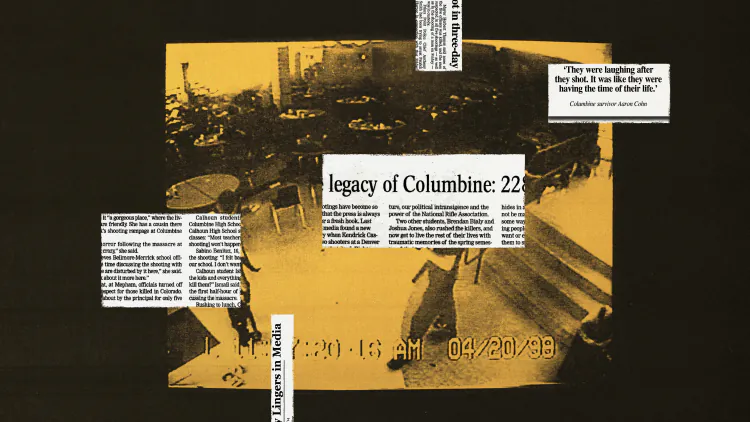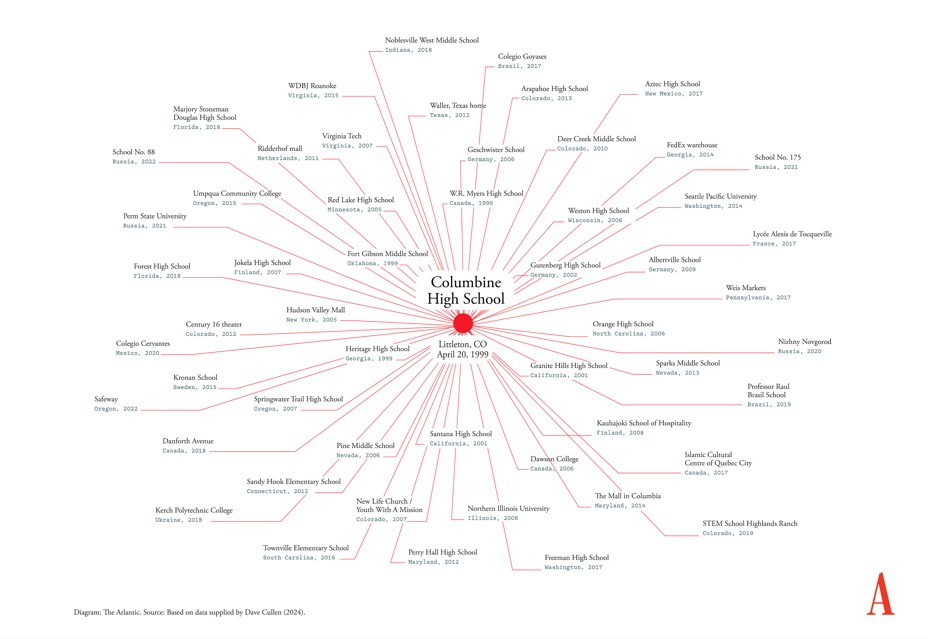The Columbine-Killers Fan Club
A quarter-century on, the school shooters’ mythology has propagated a sprawling subculture that idolizes murder and mayhem.

Mass shootings didn’t start at Columbine High, but the mass-shooter era did. Eric Harris and Dylan Klebold’s audacious plan and misread motives multiplied the stakes and inspired wave after wave of emulation. How could we know we were witnessing an origin story?
The legend of Columbine is fiction. There are two versions of the attack: what actually happened on April 20, 1999, and the story we all accepted back then. The mythical version explained it all so cleanly. A pair of outcast loners dubbed the “Trench Coat Mafia” targeted the jocks to avenge years of bullying. Dwayne Fuselier, the supervisory special agent who led the FBI’s Columbine investigation, is fond of quoting H. L. Mencken in response to the mythmaking: “There is always a well-known solution to every human problem—neat, plausible, and wrong.”
The legend hinges on bullying, but the killers never mentioned it in the huge trove of journals, online posts, and videos they left to explain themselves. The myth was so insidious because it cast the ruthless killers as heroes of misfits everywhere. Fuselier warned how appealing that myth would sound to anyone who felt ostracized. Within a few years, the fledgling fandom would find one another on social media, where they have operated ever since.
Around the world, Eric and Dylan are idolized as champions of “the nobodies.” Eric hated the nobodies. He mocked them mercilessly on his website and in his journal. He wasn’t a loner or an outcast, and neither was Dylan. Eric and Dylan made clear in their writings that they were planning the attack for their own selfish motives—certainly not to help the kids they ridiculed at the bottom of the social food chain.
They were not in the Trench Coat Mafia. They were not Nazis or white supremacists, and they did not plan the attack for Hitler’s birthday. They did not target jocks, Christians, or Black people. They targeted no one specifically. They shot randomly and designed their bombs to kill indiscriminately. That’s where “they” ends: Their polar-opposite personalities drove opposite motives. Psychopaths are devoid of empathy; Eric was a sadistic psychopath who killed for his own aggrandizement and enjoyment. Dylan was suicidally depressed and self-loathing. Eric lured him into punishing the world for the pain it inflicted on him, instead of punishing himself. Columbine was a suicide plan, but on “Judgment Day,” as they called it, Dylan would show the world the “somebody” we’d never seen.
The Columbine killers have fans. Eric and Dylan’s adoring online following spreads across nearly every continent, and it’s growing across multiple platforms. In Russia, the government, which has been plagued by an explosion of both Columbine fandom and mass shootings, estimates that more than 70,000 members exist. They call themselves the TCC, for “True Crime Community,” and I’ve spent much of the past 15 years inside their online world. My book Columbine made me enemy No. 1 for portraying Eric and Dylan as ruthless murderers.
In 2016, a young fan tweeted: “hey @DaveCullen block me or else i shoot my school.” She’d been ranting for hours, posting pictures of school shooters, and tweets such as: “It’s also something a lot of people need, To die....I wish i was dead...I LIKE VIOLENCE...I want to be killed in front of an audience. … I think someone failed to abort me (:”
These teens are ensnared in an American tragedy that just keeps growing worse.
I’ve tried to leave this story so many times, but this diagram haunts me, ruthlessly expanding like an unstoppable spider web, devouring all the lives and futures in its path. It demands that we address the cause—25 years too late. That web is made up of 54 mass shootings that have killed nearly 300 people and wounded more than 500. And every gunman left evidence that they were inspired or influenced by the murderers at Columbine. The Columbine effect.
Eric and Dylan’s bombs failed. Yet the legend made them heroic to their progeny and gave birth to their fandom. By the tenth anniversary, a small band of “Columbiners” had formed online. They gravitated to the TCC, to Ted Bundy, to the younger Tsarnaev brother, to Dylann Roof, and to others—but Eric and Dylan are the megastars. The groupies multiply, as fresh crops of teens join their ranks each season.
Most gunmen die in the act, so the 54 attacks itemized in the diagram are just the ones that we know of, and that were carried out. A 2015 Mother Jones investigation of Columbine copycats found more than two thwarted attacks for each one that succeeded. It identified 14 plotters targeting Columbine’s anniversary and 13 striving to top its body count. Surviving mass shooters have admitted that they were competing with one another.
All roads lead back to Columbine. The Virginia Tech shooter, Seung-Hui Cho, wrote in a school assignment that he wanted to “repeat Columbine” and that he idolized its “martyrs.” The Northern Illinois University killer marked a third generation, explicitly inspired by both Virginia Tech and Columbine. Sandy Hook was the fourth generation; Adam Lanza had studied all three. Six more school shooters later referenced Sandy Hook and Columbine. Five generations of fallout, all reenacting the original legend.
Most early Columbiners were just curious teenagers interested in the criminal mind or in analyzing Columbine. Many still are, and their analyses are often useful. Many are angry about being tarred with the group’s reputation, but they have been outnumbered by new arrivals unabashedly calling themselves fans. Many use the killers’ faces as avatars, extoll their virtues, and compose love poems, fan fiction, and gory memes about them. Sue Klebold said she was shocked by the volume of letters she received calling Dylan “heroic” and by the number of girls saying, “I wish I could have his baby.”
How little these groupies know about the murderers they obsess over is ironic. They keep repeating the misreporting that was debunked decades ago, convinced it’s true because it has metastasized into TCC dogma. The TCC twists the story to recast the murderers as victims; and the dead, wounded, and traumatized as villains. The groupies didn’t start these myths; we in the media bear that shame. But the groupies are now the carriers, spreading the legend of Dylan and Eric to remote reaches of the globe.
Seventy thousand is a tiny fraction of the adolescent population, but a magnet for a dangerous cohort of marginalized, disaffected, and hopeless teens—a major pool of aspiring shooters. Most TCC members outright say that they condone the Columbine murders, often in their profiles. They have turned Eric and Dylan into folk heroes, and they celebrate them as avenging angels. Adam Lanza obsessed over the Columbine killers and spent years immersed in these groups online. Then he murdered 20 little kids and six adults at Sandy Hook Elementary School.
Here’s the twist: Most of the TCC members I’ve engaged with describe themselves as awkward outcasts desperate to fit in. The TCC embraces them. The TCC feels cool—Eric and Dylan are super cool—and so they finally feel cool. I find it heartbreaking to hear them describe the pain they endure at school and the affinity they feel for “Dylan” and “Eric,” the fictional characters they’ve constructed. These kids are shocked when I tell them that other members of the TCC have told me the same—that they are putting on the same show, sure that all the others really mean it. Did Adam Lanza believe the posers? We’ll never know, but we can be certain that as you read this, a distraught, lonely kid somewhere is contemplating an attack—and the one community they trust is screaming, Do it!
Lots of kids fantasize about killing. Two days after Columbine, Salon ran “Misfits Who Don’t Kill,” in which three people came clean about their youthful fantasies of enacting mass murder. The phenomenon was widely reported that week. But none of those people did anything, because they knew how horribly wrong acting out the fantasy would be. Inside the TCC bubble, the constant message is that if your classmates are tormenting you, killing them is not just moral —it’s heroic and noble.
The TCC has a tell: Actual shootings unnerve them. Their posts grow quiet, respectful, and even mournful after some troubled young person heeds their call. I can gauge the change instantly, because the incessant harassment I get from them stops cold—for a week or two. Parkland was different: Six months went by before the taunts began trickling back in, and I haven’t gotten a death threat in the six years since. Why? I have no way to be certain about this, but my educated guess is that David Hogg, X González, and the rest of the March for Our Lives kids were suddenly cooler than the young shooters. And so much more powerful.
Eric and Dylan weren’t powerful—their plan failed. They’d planned Columbine as a bombing, the primary terrorist tactic. They thought they were launching a three-act drama: The cafeteria bombs would kill nearly 600 people instantly; what they called the “fun” part would be shooting up hundreds of survivors; and the massive car bombs set in the parking lot outside were to be the coup de grâce. Those timers were set to explode 45 minutes after the initial blast, wiping out countless more survivors and first responders, live on national TV. The Columbine killers’ performance was staged as the most apocalyptic made-for-TV horror film in American history. Eric complained in his journal that his “audience” would fail to understand. He got that right. He got everything else wrong.
Every element fizzled. All of the big bombs failed. Eric and Dylan went down to the cafeteria in a last desperate move to ignite the bombs with gunfire and a Molotov cocktail. Failed. Experts on psychopaths say they get bored after their initial kills, and Eric had likely lost interest. His gun’s recoil had broken his nose, so he spent that time in acute pain. The cops refused to kill them in the blaze of glory that they’d described as their final curtain. The smell of all the blood and already decomposing bodies was overpowering. Out of options, each shot himself in the head.
A more obscene and pathetic way to die is hard to imagine. Yet their fans have never confronted that ugly reality, because the opposite story took hold, making Eric and Dylan masterminds of the “worst school shooting in American history.”
The Columbine effect has gone global. It has inspired mass shootings in Finland, Sweden, Brazil, Mexico, Canada, France, Germany, the Netherlands, Ukraine, and Russia—as well as knife and axe attacks in places as remote as Siberia. In 2022, Russia designated the online “Columbine movement” a terrorist group. To comply with the ruling, my publisher required me to disavow the group in the Russian translation of Columbine. Mass murder inspired by those inept perpetrators is America’s most revolting cultural export.
I know when the TCC colonizes a new region, because I start getting a barrage of taunts in a different language. It’s a social contagion. Researchers have described school shootings as the American equivalent of suicide bombings—an ideology joined with a tactic. The phenomenon is escalating and self-perpetuating.
The Columbine groupies have no idea that they’re exporting a fraud. The media set this whole thing in motion 25 years ago. To untell a legend is a formidable task. It will be possible only when the media finally begin to convey how pathetic and gruesome the killers’ final moments were. The fans need to hear the ugly truth. Eric and Dylan viciously murdered innocent kids for their own selfish and petty agendas, and they died miserable failures.
This essay is adapted by the author from the new preface to a 25th-anniversary edition of Columbine.
What's Your Reaction?




















